OPER1160 - Supply Chain Management: Toyota Motors Manufacturing
VerifiedAdded on 2023/06/11
|6
|1588
|187
Report
AI Summary
This report analyzes the supply chain management practices of Toyota Motor Manufacturing Canada, focusing on career roles like Purchase Manager, critical operations management decisions (human resources, process design, inventory, location, quality), and the company's mission, strategies, and competitive advantages. It highlights Toyota's use of market penetration, product development, and just-in-time manufacturing to enhance efficiency and customer satisfaction. The report also touches upon the role of quality management and strategic location in ensuring timely delivery and product excellence. This document is available on Desklib, a platform offering a wealth of study resources for students.
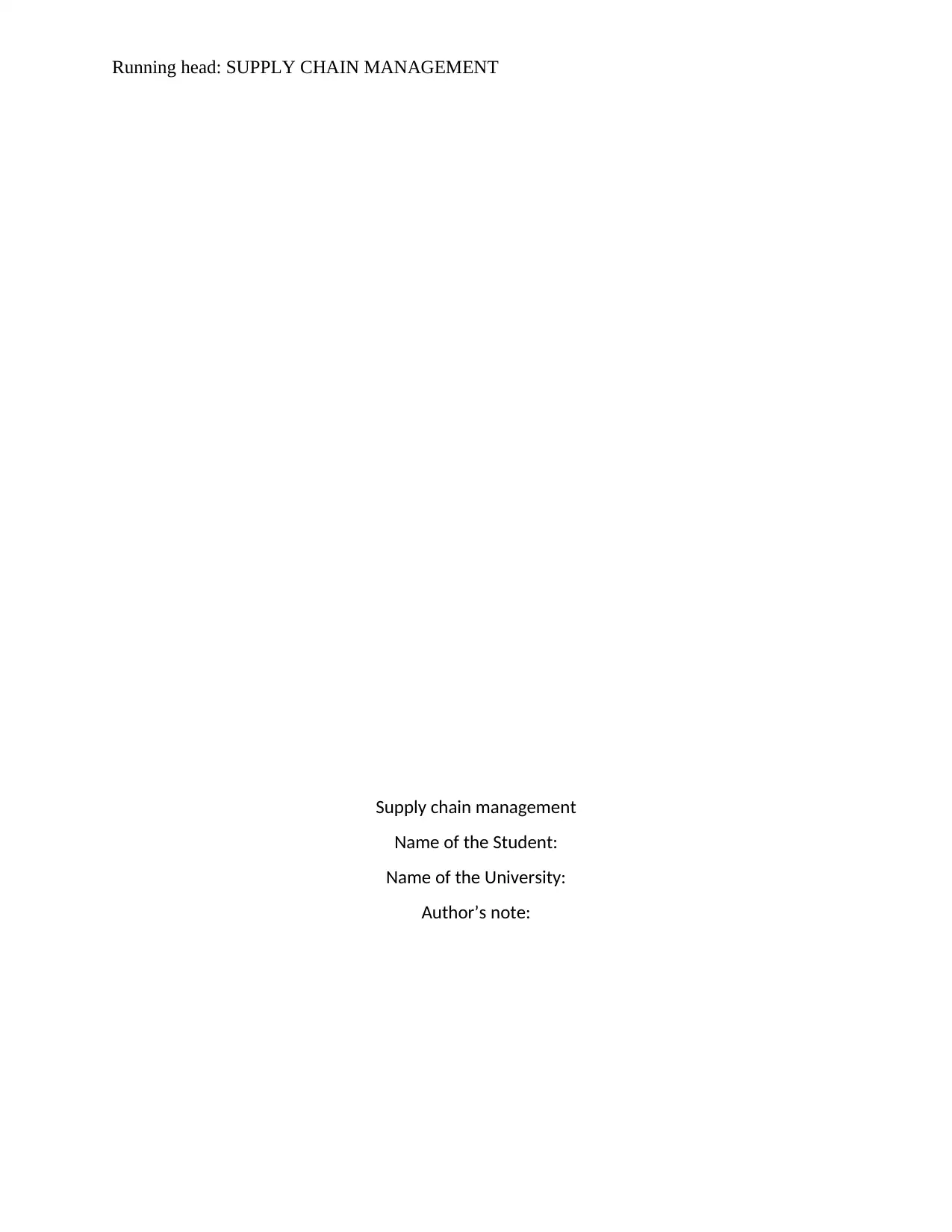
Running head: SUPPLY CHAIN MANAGEMENT
Supply chain management
Name of the Student:
Name of the University:
Author’s note:
Supply chain management
Name of the Student:
Name of the University:
Author’s note:
Paraphrase This Document
Need a fresh take? Get an instant paraphrase of this document with our AI Paraphraser
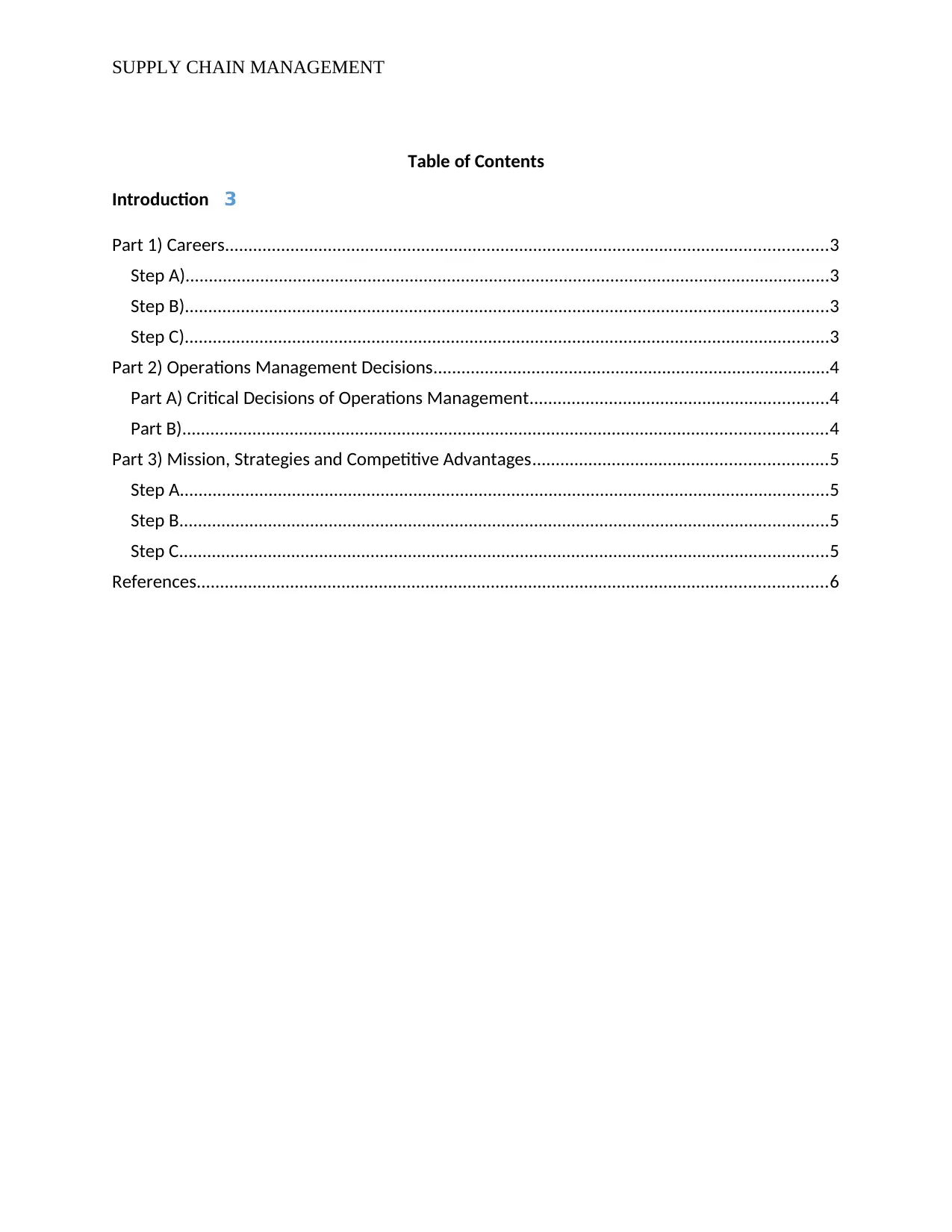
SUPPLY CHAIN MANAGEMENT
Table of Contents
Introduction 3
Part 1) Careers.................................................................................................................................3
Step A)..........................................................................................................................................3
Step B)..........................................................................................................................................3
Step C)..........................................................................................................................................3
Part 2) Operations Management Decisions.....................................................................................4
Part A) Critical Decisions of Operations Management................................................................4
Part B)..........................................................................................................................................4
Part 3) Mission, Strategies and Competitive Advantages...............................................................5
Step A...........................................................................................................................................5
Step B...........................................................................................................................................5
Step C...........................................................................................................................................5
References.......................................................................................................................................6
Table of Contents
Introduction 3
Part 1) Careers.................................................................................................................................3
Step A)..........................................................................................................................................3
Step B)..........................................................................................................................................3
Step C)..........................................................................................................................................3
Part 2) Operations Management Decisions.....................................................................................4
Part A) Critical Decisions of Operations Management................................................................4
Part B)..........................................................................................................................................4
Part 3) Mission, Strategies and Competitive Advantages...............................................................5
Step A...........................................................................................................................................5
Step B...........................................................................................................................................5
Step C...........................................................................................................................................5
References.......................................................................................................................................6
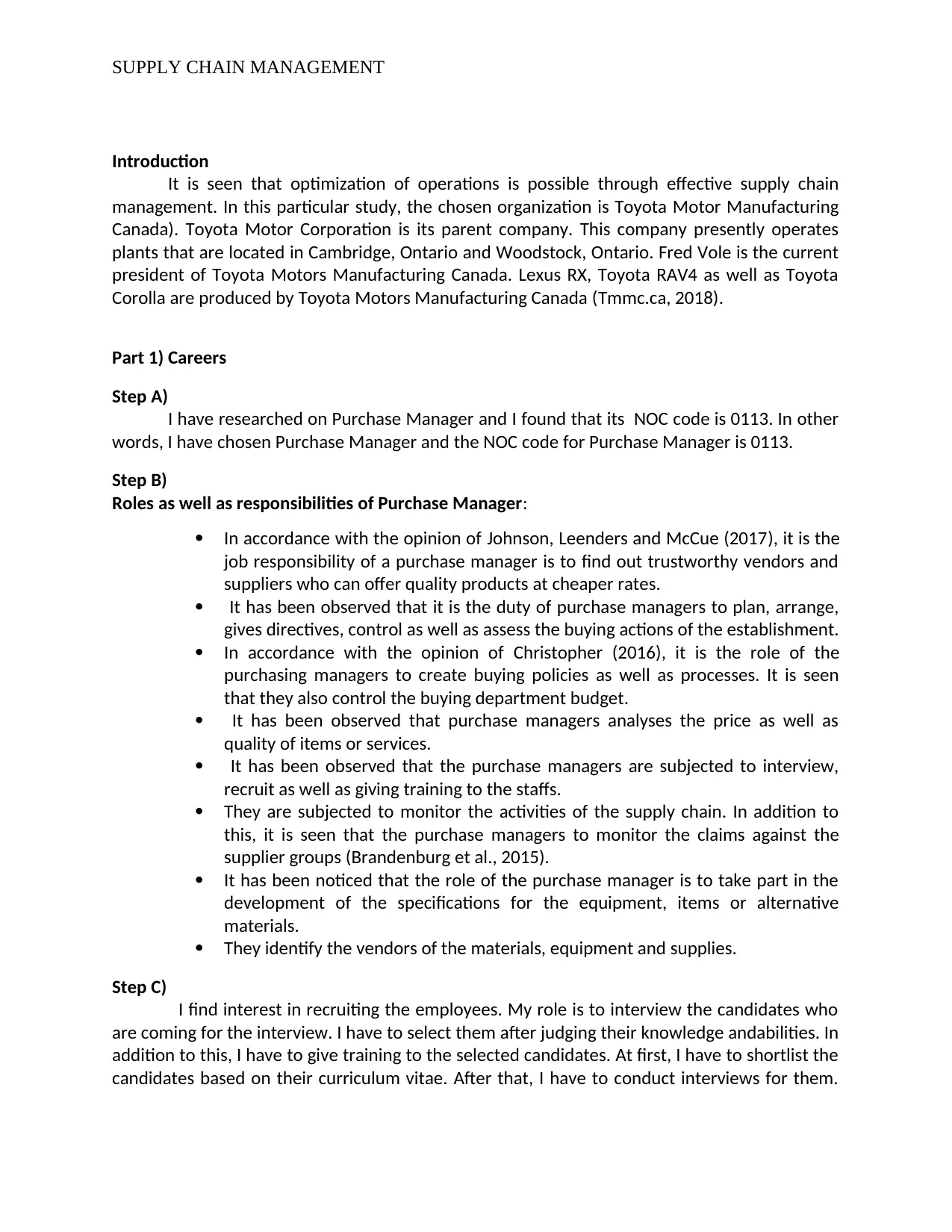
SUPPLY CHAIN MANAGEMENT
Introduction
It is seen that optimization of operations is possible through effective supply chain
management. In this particular study, the chosen organization is Toyota Motor Manufacturing
Canada). Toyota Motor Corporation is its parent company. This company presently operates
plants that are located in Cambridge, Ontario and Woodstock, Ontario. Fred Vole is the current
president of Toyota Motors Manufacturing Canada. Lexus RX, Toyota RAV4 as well as Toyota
Corolla are produced by Toyota Motors Manufacturing Canada (Tmmc.ca, 2018).
Part 1) Careers
Step A)
I have researched on Purchase Manager and I found that its NOC code is 0113. In other
words, I have chosen Purchase Manager and the NOC code for Purchase Manager is 0113.
Step B)
Roles as well as responsibilities of Purchase Manager:
In accordance with the opinion of Johnson, Leenders and McCue (2017), it is the
job responsibility of a purchase manager is to find out trustworthy vendors and
suppliers who can offer quality products at cheaper rates.
It has been observed that it is the duty of purchase managers to plan, arrange,
gives directives, control as well as assess the buying actions of the establishment.
In accordance with the opinion of Christopher (2016), it is the role of the
purchasing managers to create buying policies as well as processes. It is seen
that they also control the buying department budget.
It has been observed that purchase managers analyses the price as well as
quality of items or services.
It has been observed that the purchase managers are subjected to interview,
recruit as well as giving training to the staffs.
They are subjected to monitor the activities of the supply chain. In addition to
this, it is seen that the purchase managers to monitor the claims against the
supplier groups (Brandenburg et al., 2015).
It has been noticed that the role of the purchase manager is to take part in the
development of the specifications for the equipment, items or alternative
materials.
They identify the vendors of the materials, equipment and supplies.
Step C)
I find interest in recruiting the employees. My role is to interview the candidates who
are coming for the interview. I have to select them after judging their knowledge andabilities. In
addition to this, I have to give training to the selected candidates. At first, I have to shortlist the
candidates based on their curriculum vitae. After that, I have to conduct interviews for them.
Introduction
It is seen that optimization of operations is possible through effective supply chain
management. In this particular study, the chosen organization is Toyota Motor Manufacturing
Canada). Toyota Motor Corporation is its parent company. This company presently operates
plants that are located in Cambridge, Ontario and Woodstock, Ontario. Fred Vole is the current
president of Toyota Motors Manufacturing Canada. Lexus RX, Toyota RAV4 as well as Toyota
Corolla are produced by Toyota Motors Manufacturing Canada (Tmmc.ca, 2018).
Part 1) Careers
Step A)
I have researched on Purchase Manager and I found that its NOC code is 0113. In other
words, I have chosen Purchase Manager and the NOC code for Purchase Manager is 0113.
Step B)
Roles as well as responsibilities of Purchase Manager:
In accordance with the opinion of Johnson, Leenders and McCue (2017), it is the
job responsibility of a purchase manager is to find out trustworthy vendors and
suppliers who can offer quality products at cheaper rates.
It has been observed that it is the duty of purchase managers to plan, arrange,
gives directives, control as well as assess the buying actions of the establishment.
In accordance with the opinion of Christopher (2016), it is the role of the
purchasing managers to create buying policies as well as processes. It is seen
that they also control the buying department budget.
It has been observed that purchase managers analyses the price as well as
quality of items or services.
It has been observed that the purchase managers are subjected to interview,
recruit as well as giving training to the staffs.
They are subjected to monitor the activities of the supply chain. In addition to
this, it is seen that the purchase managers to monitor the claims against the
supplier groups (Brandenburg et al., 2015).
It has been noticed that the role of the purchase manager is to take part in the
development of the specifications for the equipment, items or alternative
materials.
They identify the vendors of the materials, equipment and supplies.
Step C)
I find interest in recruiting the employees. My role is to interview the candidates who
are coming for the interview. I have to select them after judging their knowledge andabilities. In
addition to this, I have to give training to the selected candidates. At first, I have to shortlist the
candidates based on their curriculum vitae. After that, I have to conduct interviews for them.
⊘ This is a preview!⊘
Do you want full access?
Subscribe today to unlock all pages.

Trusted by 1+ million students worldwide
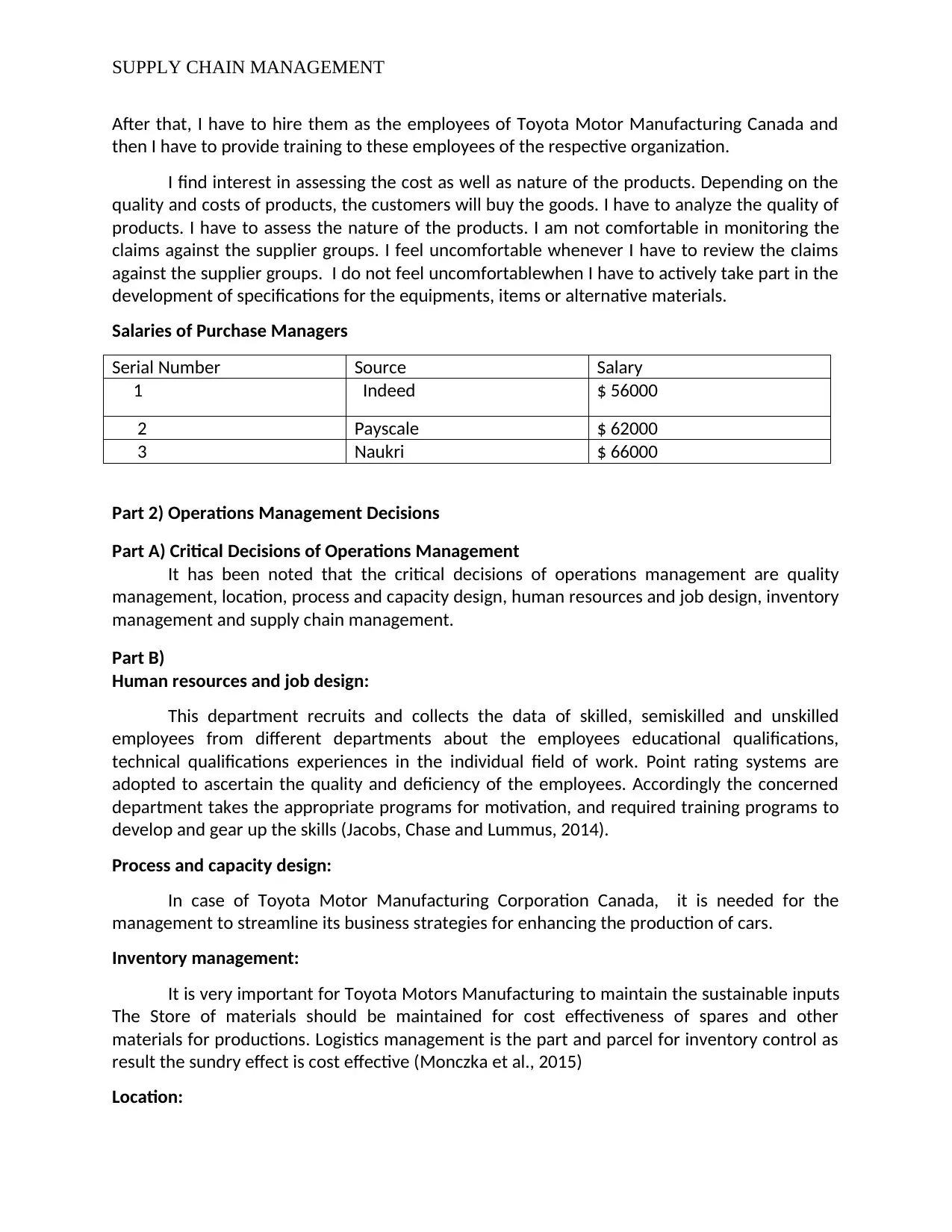
SUPPLY CHAIN MANAGEMENT
After that, I have to hire them as the employees of Toyota Motor Manufacturing Canada and
then I have to provide training to these employees of the respective organization.
I find interest in assessing the cost as well as nature of the products. Depending on the
quality and costs of products, the customers will buy the goods. I have to analyze the quality of
products. I have to assess the nature of the products. I am not comfortable in monitoring the
claims against the supplier groups. I feel uncomfortable whenever I have to review the claims
against the supplier groups. I do not feel uncomfortablewhen I have to actively take part in the
development of specifications for the equipments, items or alternative materials.
Salaries of Purchase Managers
Serial Number Source Salary
1 Indeed $ 56000
2 Payscale $ 62000
3 Naukri $ 66000
Part 2) Operations Management Decisions
Part A) Critical Decisions of Operations Management
It has been noted that the critical decisions of operations management are quality
management, location, process and capacity design, human resources and job design, inventory
management and supply chain management.
Part B)
Human resources and job design:
This department recruits and collects the data of skilled, semiskilled and unskilled
employees from different departments about the employees educational qualifications,
technical qualifications experiences in the individual field of work. Point rating systems are
adopted to ascertain the quality and deficiency of the employees. Accordingly the concerned
department takes the appropriate programs for motivation, and required training programs to
develop and gear up the skills (Jacobs, Chase and Lummus, 2014).
Process and capacity design:
In case of Toyota Motor Manufacturing Corporation Canada, it is needed for the
management to streamline its business strategies for enhancing the production of cars.
Inventory management:
It is very important for Toyota Motors Manufacturing to maintain the sustainable inputs
The Store of materials should be maintained for cost effectiveness of spares and other
materials for productions. Logistics management is the part and parcel for inventory control as
result the sundry effect is cost effective (Monczka et al., 2015)
Location:
After that, I have to hire them as the employees of Toyota Motor Manufacturing Canada and
then I have to provide training to these employees of the respective organization.
I find interest in assessing the cost as well as nature of the products. Depending on the
quality and costs of products, the customers will buy the goods. I have to analyze the quality of
products. I have to assess the nature of the products. I am not comfortable in monitoring the
claims against the supplier groups. I feel uncomfortable whenever I have to review the claims
against the supplier groups. I do not feel uncomfortablewhen I have to actively take part in the
development of specifications for the equipments, items or alternative materials.
Salaries of Purchase Managers
Serial Number Source Salary
1 Indeed $ 56000
2 Payscale $ 62000
3 Naukri $ 66000
Part 2) Operations Management Decisions
Part A) Critical Decisions of Operations Management
It has been noted that the critical decisions of operations management are quality
management, location, process and capacity design, human resources and job design, inventory
management and supply chain management.
Part B)
Human resources and job design:
This department recruits and collects the data of skilled, semiskilled and unskilled
employees from different departments about the employees educational qualifications,
technical qualifications experiences in the individual field of work. Point rating systems are
adopted to ascertain the quality and deficiency of the employees. Accordingly the concerned
department takes the appropriate programs for motivation, and required training programs to
develop and gear up the skills (Jacobs, Chase and Lummus, 2014).
Process and capacity design:
In case of Toyota Motor Manufacturing Corporation Canada, it is needed for the
management to streamline its business strategies for enhancing the production of cars.
Inventory management:
It is very important for Toyota Motors Manufacturing to maintain the sustainable inputs
The Store of materials should be maintained for cost effectiveness of spares and other
materials for productions. Logistics management is the part and parcel for inventory control as
result the sundry effect is cost effective (Monczka et al., 2015)
Location:
Paraphrase This Document
Need a fresh take? Get an instant paraphrase of this document with our AI Paraphraser
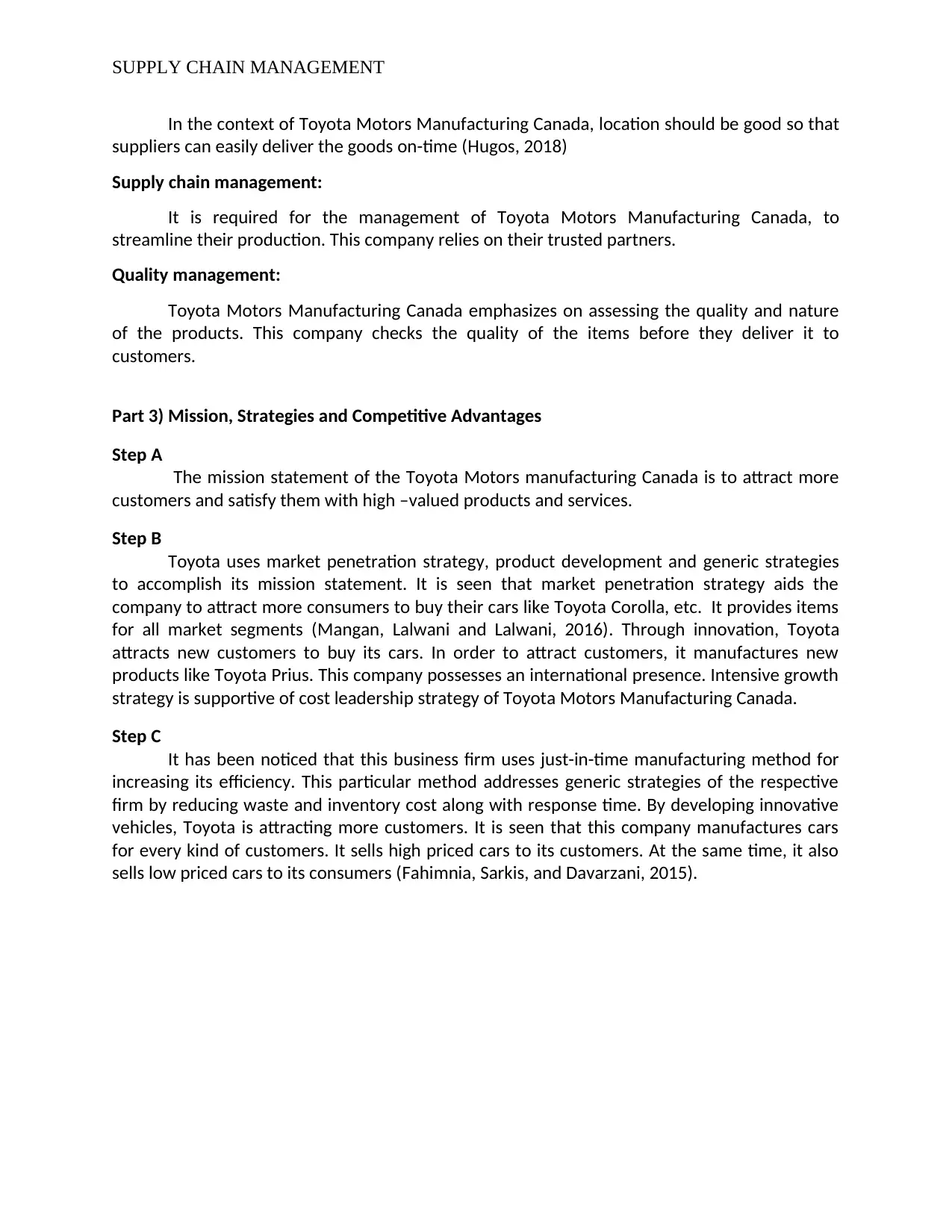
SUPPLY CHAIN MANAGEMENT
In the context of Toyota Motors Manufacturing Canada, location should be good so that
suppliers can easily deliver the goods on-time (Hugos, 2018)
Supply chain management:
It is required for the management of Toyota Motors Manufacturing Canada, to
streamline their production. This company relies on their trusted partners.
Quality management:
Toyota Motors Manufacturing Canada emphasizes on assessing the quality and nature
of the products. This company checks the quality of the items before they deliver it to
customers.
Part 3) Mission, Strategies and Competitive Advantages
Step A
The mission statement of the Toyota Motors manufacturing Canada is to attract more
customers and satisfy them with high –valued products and services.
Step B
Toyota uses market penetration strategy, product development and generic strategies
to accomplish its mission statement. It is seen that market penetration strategy aids the
company to attract more consumers to buy their cars like Toyota Corolla, etc. It provides items
for all market segments (Mangan, Lalwani and Lalwani, 2016). Through innovation, Toyota
attracts new customers to buy its cars. In order to attract customers, it manufactures new
products like Toyota Prius. This company possesses an international presence. Intensive growth
strategy is supportive of cost leadership strategy of Toyota Motors Manufacturing Canada.
Step C
It has been noticed that this business firm uses just-in-time manufacturing method for
increasing its efficiency. This particular method addresses generic strategies of the respective
firm by reducing waste and inventory cost along with response time. By developing innovative
vehicles, Toyota is attracting more customers. It is seen that this company manufactures cars
for every kind of customers. It sells high priced cars to its customers. At the same time, it also
sells low priced cars to its consumers (Fahimnia, Sarkis, and Davarzani, 2015).
In the context of Toyota Motors Manufacturing Canada, location should be good so that
suppliers can easily deliver the goods on-time (Hugos, 2018)
Supply chain management:
It is required for the management of Toyota Motors Manufacturing Canada, to
streamline their production. This company relies on their trusted partners.
Quality management:
Toyota Motors Manufacturing Canada emphasizes on assessing the quality and nature
of the products. This company checks the quality of the items before they deliver it to
customers.
Part 3) Mission, Strategies and Competitive Advantages
Step A
The mission statement of the Toyota Motors manufacturing Canada is to attract more
customers and satisfy them with high –valued products and services.
Step B
Toyota uses market penetration strategy, product development and generic strategies
to accomplish its mission statement. It is seen that market penetration strategy aids the
company to attract more consumers to buy their cars like Toyota Corolla, etc. It provides items
for all market segments (Mangan, Lalwani and Lalwani, 2016). Through innovation, Toyota
attracts new customers to buy its cars. In order to attract customers, it manufactures new
products like Toyota Prius. This company possesses an international presence. Intensive growth
strategy is supportive of cost leadership strategy of Toyota Motors Manufacturing Canada.
Step C
It has been noticed that this business firm uses just-in-time manufacturing method for
increasing its efficiency. This particular method addresses generic strategies of the respective
firm by reducing waste and inventory cost along with response time. By developing innovative
vehicles, Toyota is attracting more customers. It is seen that this company manufactures cars
for every kind of customers. It sells high priced cars to its customers. At the same time, it also
sells low priced cars to its consumers (Fahimnia, Sarkis, and Davarzani, 2015).
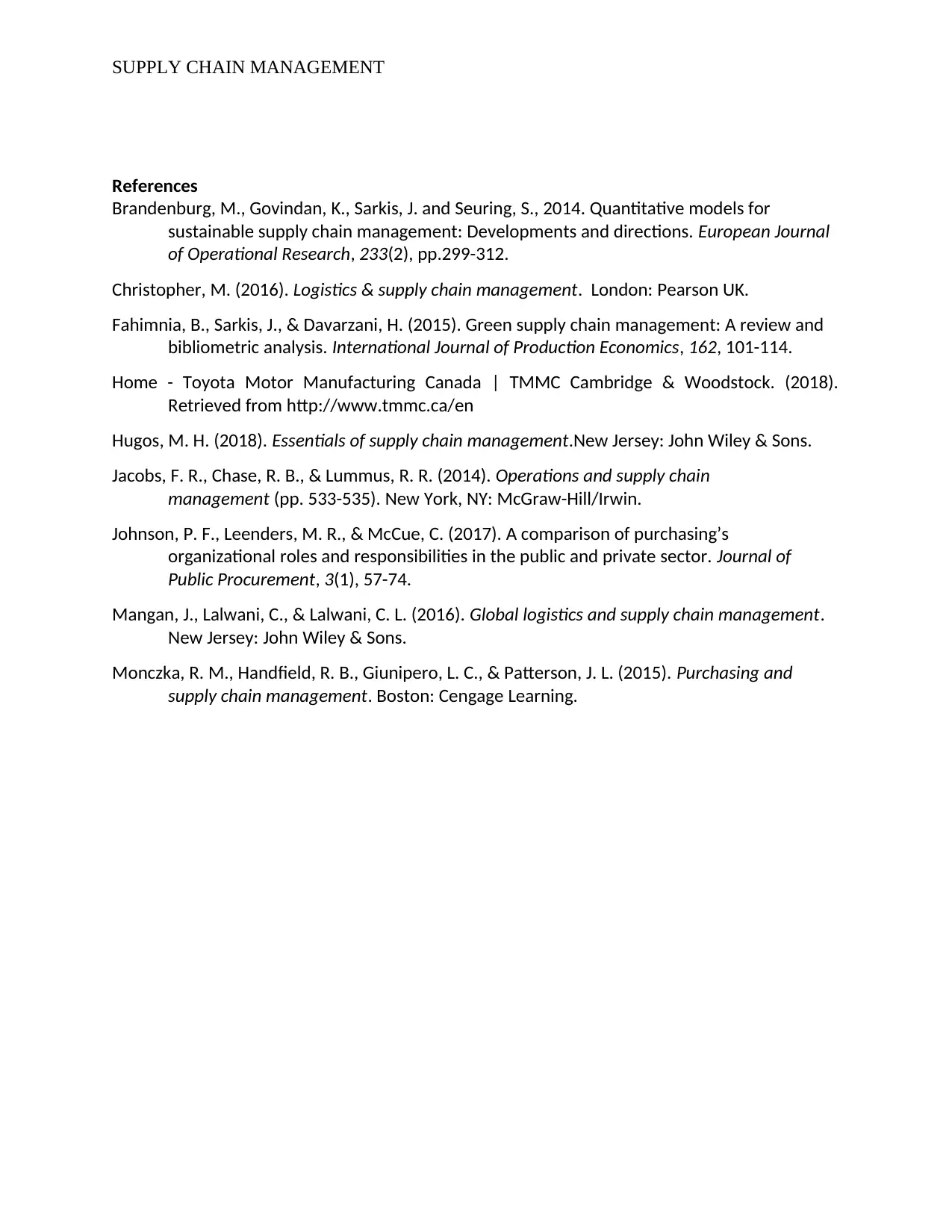
SUPPLY CHAIN MANAGEMENT
References
Brandenburg, M., Govindan, K., Sarkis, J. and Seuring, S., 2014. Quantitative models for
sustainable supply chain management: Developments and directions. European Journal
of Operational Research, 233(2), pp.299-312.
Christopher, M. (2016). Logistics & supply chain management. London: Pearson UK.
Fahimnia, B., Sarkis, J., & Davarzani, H. (2015). Green supply chain management: A review and
bibliometric analysis. International Journal of Production Economics, 162, 101-114.
Home - Toyota Motor Manufacturing Canada | TMMC Cambridge & Woodstock. (2018).
Retrieved from http://www.tmmc.ca/en
Hugos, M. H. (2018). Essentials of supply chain management.New Jersey: John Wiley & Sons.
Jacobs, F. R., Chase, R. B., & Lummus, R. R. (2014). Operations and supply chain
management (pp. 533-535). New York, NY: McGraw-Hill/Irwin.
Johnson, P. F., Leenders, M. R., & McCue, C. (2017). A comparison of purchasing’s
organizational roles and responsibilities in the public and private sector. Journal of
Public Procurement, 3(1), 57-74.
Mangan, J., Lalwani, C., & Lalwani, C. L. (2016). Global logistics and supply chain management.
New Jersey: John Wiley & Sons.
Monczka, R. M., Handfield, R. B., Giunipero, L. C., & Patterson, J. L. (2015). Purchasing and
supply chain management. Boston: Cengage Learning.
References
Brandenburg, M., Govindan, K., Sarkis, J. and Seuring, S., 2014. Quantitative models for
sustainable supply chain management: Developments and directions. European Journal
of Operational Research, 233(2), pp.299-312.
Christopher, M. (2016). Logistics & supply chain management. London: Pearson UK.
Fahimnia, B., Sarkis, J., & Davarzani, H. (2015). Green supply chain management: A review and
bibliometric analysis. International Journal of Production Economics, 162, 101-114.
Home - Toyota Motor Manufacturing Canada | TMMC Cambridge & Woodstock. (2018).
Retrieved from http://www.tmmc.ca/en
Hugos, M. H. (2018). Essentials of supply chain management.New Jersey: John Wiley & Sons.
Jacobs, F. R., Chase, R. B., & Lummus, R. R. (2014). Operations and supply chain
management (pp. 533-535). New York, NY: McGraw-Hill/Irwin.
Johnson, P. F., Leenders, M. R., & McCue, C. (2017). A comparison of purchasing’s
organizational roles and responsibilities in the public and private sector. Journal of
Public Procurement, 3(1), 57-74.
Mangan, J., Lalwani, C., & Lalwani, C. L. (2016). Global logistics and supply chain management.
New Jersey: John Wiley & Sons.
Monczka, R. M., Handfield, R. B., Giunipero, L. C., & Patterson, J. L. (2015). Purchasing and
supply chain management. Boston: Cengage Learning.
⊘ This is a preview!⊘
Do you want full access?
Subscribe today to unlock all pages.

Trusted by 1+ million students worldwide
1 out of 6
Related Documents
Your All-in-One AI-Powered Toolkit for Academic Success.
+13062052269
info@desklib.com
Available 24*7 on WhatsApp / Email
![[object Object]](/_next/static/media/star-bottom.7253800d.svg)
Unlock your academic potential
Copyright © 2020–2025 A2Z Services. All Rights Reserved. Developed and managed by ZUCOL.



